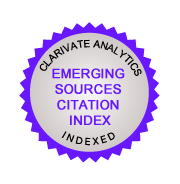The perspective of university students on the school as a promoter of health and healthy lifestyle
DOI:
https://doi.org/10.24310/innoeduca.2017.v3i2.2478Keywords:
Health education, Healthy living, WelfareAbstract
Healthy Education is a basic dimension in the 21st-century scholar functions. In this paper is shown the more highlighted outcomes from a research about understanding attitudes and perceptions from university students about the role of the school for boosting a healthy style of life. An ad-hoc questionnaire was applied to 115 students from the Faculty of Education of the University of Málaga. The main conclusion is student have a very positive image about the Education for Health, and its inclusion in the curriculum. However, they are critics about a real engagement from schools for developing healthy habits.
Downloads
Metrics
Publication Facts
Reviewer profiles N/A
Author statements
Indexed in
-
—
- Academic society
- N/A
- Publisher
- Universidad de Málaga
References
Cubero, J., Calderón, M., Costillo, E., & Ruiz, C. (2011). La Educación para la Salud en el Espacio Europeo de educación superior. Publicaciones, 41, 51-63.
Gavidia, V. (2001). La transversalidad y la escuela promotora de salud. Revista Española de Salud Publica. 75 (6), 505-516.
Giraldo, A., Toro, M. Y., Macías, A. M., Garcés, V., Andrés, C., & Palacio, S. (2010). La promoción de la salud como estrategia para el fomento de estilos de vida saludables. Hacia la Promoción de la Salud, 15(1), 128-143.
Gonzalez de Haro Mª. D. (2008). La Educación para la Salud: “asignatura pendiente para la escuela”, XXI Revista de Educación. 10, 123-136.
Macías, A. I., Gordillo, L. G., & Camacho, E. J. (2012). Hábitos alimentarios de niños en edad escolar y el papel de la Educación para la Salud. Revista chilena de nutrición, 39 (3), 40-43.
Muñoz M. & Cabieses B. (2008). Universidades y pro- moción de la salud: ¿cómo alcanzar el punto de encuentro? Revista Panameña de Salud Pública, 24 (2), 139–146.
Rochon, A. (2001). Educación para la Salud. Guía práctica para realizar proyectos. Barcelona: Masson.
Downloads
Published
How to Cite
Issue
Section
License
All contents published by Innoeduca. International Journal of Technology and Educational Innovation are subject to Creative Commons Attribution-Nocomercial-NoDerivatives 4.0 International License, whose complete text can be consulted at https://creativecommons.org/licenses/by-nc-nd/4.0/legalcode. Thus, copying, distribution, public communication, derivative works and commercial use of content are permitted as of the aforementioned issue provided that the source and the author of the text are cited.
It is the responsibility of the authors to obtain the necessary permits for images that are subject to copyright.

This work is licensed under a Creative Commons Attribution-NonCommercial-NoDerivatives 4.0 International License.












242.png)








